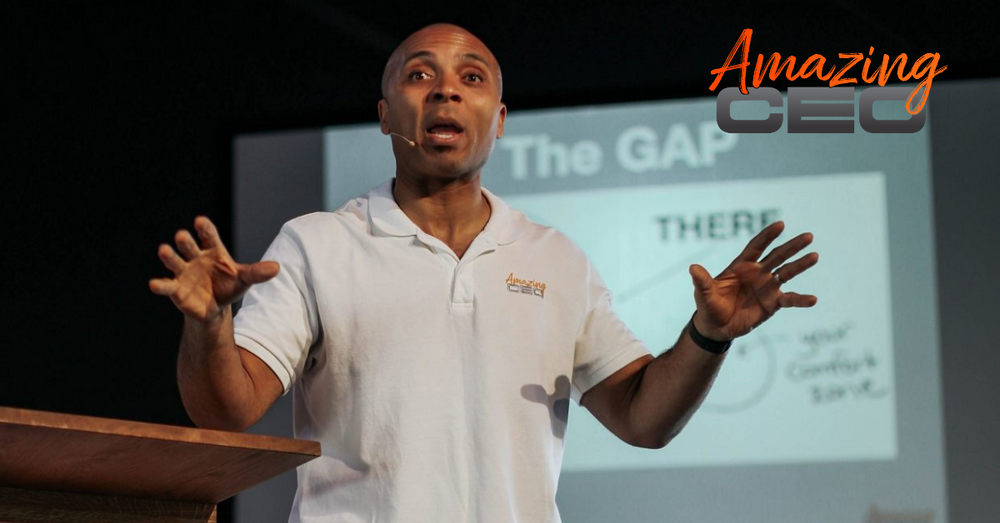13 Tips For Giving A Phenomenal (and profitable) Speech
I’ve come across some phenomenal speakers in my day; unfortunately, not all of them were phenomenally paid. Many of them were making very little money for their time and effort. Because they didn’t know or understand the nuances of how to give a speech, let alone how to give a speech that keeps the audience engaged, creates suspense, and is insanely profitable.
In my course, Speaking Like A Leader, we walk through my signature step-by-step process for speech writing. We cover weaving your 3E’s (experience, expertise, and education), your Origin Brand Story, and Charismatic Cliffhanger into a presentation that will captivate your audience whether you’re selling from the stage or not.
To deliver a powerful message that will leave your audience hanging on your every word, here are 13 tips.
How To Prepare A Speech
When giving a speech, preparation is of the utmost importance. Most people fear public speaking. Even if you don’t, don’t underestimate the power of being prepared. When I’m coaching my clients in preparing their presentations, I tell them to expect the unexpected.
Plan your speech
Before you start writing, take the time to plan your points. What is the message that you want to deliver? This will help ensure that your presentation flows well and that you cover all the essential issues.
Create a backup plan
Unfortunately, things go wrong. A slide may not work. The sound system might not be ideal any number of things can go wrong that are out of your control. The best way to deal with the unexpected is to have a backup plan.
For example, if you’re using slides, have a backup on your computer and a USB drive. If you’re using a teleprompter, have your speech printed so you can refer to it if needed.
Your speech’s structure
Once you have a general idea of what you want to say, create an outline of your speech. An overview will keep you on track and ensure that each point is covered.
A basic overview should include:
1. Create a captivating introduction
2. Briefly explain your background
3. Explain how your background relates to your topic
3. Introduce your topic
4. Cover the main points of your speech
5. Summarize your points
The Speech Cheatsheet
Now it’s time to start writing! Start with your captivating introduction. Here’s a cheat sheet for you:
Good morning (or afternoon), everyone. My name is ________ and I am the (title) of _____ (company/organization). I am very excited to be here today to talk to you about _____ (topic).
Then move into your background story.
I got my start in _____ (industry) when _____ (an event that led you to your current path).
Since then, I have _____ (explain your journey).
This experience has allowed me to see _____ (a perspective that you have gained).
Now, introduce your topic.
Today, I want to talk to you about _____ (topic). This is important because _____ (the reason why your issue is essential).
Next, cover the main points of your speech. Remember to keep it engaging. Use stories, examples, and data to support your points.
Lastly, summarize your key points.
In summary, _____ (restate your main points).
Be sure to end with a solid call to action.
Practice, practice, practice
It’s essential to practice your speech before you deliver it. This will help ensure that you know it well and are comfortable with it. The more you practice, the more confident you will be. You can practice in front of a mirror, with friends or family, or even by recording yourself. Pay attention to your body language and voice.
Your body language and voice greatly influence how your audience perceives you. Crossing your arms or legs can make you appear closed off. Make eye contact with as many people as possible.
Time your speech
Be sure to time your presentation before delivering it to know how long it is. Being prepared will help keep you on track and avoid over or under time. Going over your allotted time is unacceptable and can be considered unprofessional in the eyes of others.
How To Keep The Crowd’s Attention
Control the energy in the room
It’s vital to be energetic when giving a speech. Your energy will help keep the crowd’s attention and engage more. If the attendees are low energy, try to inject some enthusiasm into your voice; if the crowd is too high energy, tone it down so you don’t come across as frantic.
Use visuals
Use visuals such as graphs, charts, or images to help illustrate your points. Visuals will help people follow along and understand your message better. You can also use visuals to add a little comedic relief.
Move around the stage.
This also helps you project your voice better. Moving also keeps the crowd engaged as it creates energy.
Make eye contact
Make eye contact with different members of the audience to keep them engaged. Have you ever noticed that during some of the most famous speeches of our decade, the orator always used eye contact with the crowd and sometimes the camera to drive their point home? This is because eye contact is essential when delivering a speech. It makes the audience feel like you are speaking to them directly and not just giving a rehearsed speech.
Use humor
Use humor sparingly; when you keep your audience and the setting in mind, the proper joke can lighten the mood, create camaraderie, and keep the audience’s attention. Keep your audience and setting in mind when using humor.
Vary your tone and volume
Vary your tone and volume throughout your speech to keep the audience engaged. When making a point, lower your voice to create suspense and raise your voice when you want to emphasize something. Pause for effect; use pauses throughout your presentation for effect. This helps to keep the audience’s attention and creates suspense.
Tell stories
People love stories. When speaking to an audience, give accounts that engage the audience by asking them questions or getting them to participate in activities.
So, you’ve learned how to keep your audience’s attention from beginning to end. You’ve perfected your body language, timing, and tone. You’ve used humor and visuals to engage them even further. Now it’s time to bring it all together and deliver a powerful closing that summarizes your main points.
Remember, speaking is your opportunity to drive home your message and leave a lasting impression on your audience. If you are ready to become a Master Communicator, speak to one of our Coaches about our Signature Program Speaking Like A Leader.
The Business To BRAND Mastermind Recap
If you missed The Business To Brand Mastermind, you MISSED out! The Brand Team and I headed to the Marriott Resort and Spa last week for a phenomenal 3-Day Live Event, and it was non-stop energy from the beginning to the end. In this article, I want to share a few highlights. To be notified about the next event, join the email list.
In our first session, we had the pleasure of hearing from Dan Lok. If you don’t know who Dan Lok is, he’s a business -mogul, author, and philanthropist. H He’s also the author of the bestseller F.U. Money: Make as Much Money as You Want.

In his talk, Dan shared phenomenal wisdom with The Business To Brand attendees about making the mental shift to change your identity from a six-figure to a seven-figure earner. You’ve probably heard about shifting your identity so let me share some insight from an evidence-based coaching perspective on how you can make this happen.
An identity shift is about changing your habits. To change your habits, you must define:
- What are the practices of a seven-figure earner?
- How can you make those habits part of your daily routine?
Some of the shifts Dan spoke about included:
- Investing in your mindset
- Being unapologetic about your goals
- Continuously learning and expanding your knowledge
- Taking massive action from a place of assurance vs. fear.
Quotable: “Get into the business of helping winners, when more” – Dan Lok
Next, we had Anthony Flynn, the founder of Amazing CEO, on our virtual stage.

Anthony is a follow-through and productivity expert with a wealth of experience in successfully leading businesses and high-earners to new heights. He’s worked with the highly sought-after Eric Thomas and brands ranging from Chic-Fil-A to the NFL. Anthony excels at translating ideas into actionable plans that produce tangible results. Anthony outlined how vital it is to identify your target market and operate from your unique strengths.
Some of the key takeaways from Anthony’s talk were:
- Position your brand where your audience is and know who you are targeting
- Your Unique Selling Proposition separates you from everyone else in your industry, so make sure it is clear and concise.
- Create your signature framework and infuse your DNA into everything you do.
Quotable: “Don’t overestimate who you ACTUALLY are, while underestimating who you REALLY can be” -Anthony Flynn
Last but not least was our M.C., the one and only June Archer, a former Executive and highly sought-after change agent. June discussed the Power of Reinvention through Personal Branding. June has worked with artists like Jay Z and other industry executives like Russell Simmons. The key to June’s success is his ability to connect authentically.

As he put it,
“Your brand extends beyond you; your reputation will dictate how the people connected to you will be perceived.
If you want to change how people see you, it starts with being authentic and genuine.
June went on to say that to reinvent yourself successfully; you have to have a solid reputation that you can fall back on.
Some of the critical points from June’s talk were:
- Seeing closed doors as opportunities for growth
- Leveraging your MVPs (morals, values, and principles) to solidify your brand
- The importance of remaining authentic and transparent
The Business to Brand Mastermind was an event you did not want to miss. We had some of the most brilliant minds in the industry sharing their wisdom with us. Sign up for the email list to be notified of the next event if you missed it.
6 Tips for Leveraging Your Personal Brand to Create Partnership Opportunities
11 Ways to Brand Yourself as a Speaker
How To Build A Positive Company Culture With Remote Teams
How do you build a phenomenal company culture when managing a global team that works remotely? The era of remote work has also become the age of the “life first” approach to business, where autocratic leadership is obsolete. These two shifts can be difficult for leaders accustomed to a brick-and-mortar environment and authoritarian leadership style. Autocratic Leadership is defined as a leadership style of complete control. The leader oversees all decisions and aspects of the project or organization.
How Autocratic Leadership & The Business Over Life Approach Impact Company Culture
- It stifles creativity and innovation.
- Lowers employee engagement
- Leads to high-turnover rates as top talent takes advantage of remote opportunities.
A new study by Kantata reported that “senior executives at professional services organizations spend 40% of their time each day dealing with employee turnover, and over half (53%) have a problem hiring full-time employees (Kantata, 2022)
The good news is the principles of building a positive culture are the same, whether your team is in an office or global. In this article, I will define culture in 2022 and share examples of companies known for their phenomenal work environments and principles that you can adopt in your business- when leading remotely.
What Is A Positive Company Culture?
Company culture is an organization’s collective core values, behaviors, and attitudes. It’s what makes your business unique and defines how employees interact with one another. Leaders who adopt a “life first” approach to business can shape their company culture through their policies, procedures, and initiatives. For example, if you value family first, you can model this by:
- Celebrating family milestones together. Leaders can celebrate family milestones with their remote team members to create a sense of community and kinship.
- Encouraging team members to take time off to spend with family. This could be done by unlimited vacation days or late start times during holidays and summer.
Company culture is critical for leaders with Personal Brands that drive business success. The more influential you are, the more stakeholders want to know about your team and their work environment. Just look at how often Microsoft and Amazon employees are interviewed and quoted in the press. I’ve found that the strongest cultures are those your team has a hand in creating. Sit down with your management team and brainstorm ways to increase employee satisfaction. If you work with contractors, you can still create a positive culture while respecting their autonomy (and rights). Looking across industries for best practices is another strategy you can use to shape your company’s culture.
Organizations Known For Their Positive Cultures
I’m not here to debate whether I agree or disagree with Chic-Fil-A’s stance on social issues in recent years. I want to focus on the company’s customer service track record, as reported by numerous surveys.
The fast food chain is known for high employee retention rates. Customers expect to be addressed by name and greeted with common courtesy. Their employees seem happy, which leads to positive customer interactions. In an article by Mashed, a franchise owner stated that this is because, during interviews, they place a significant emphasis on hiring people with positive attitudes. Does your interview process place equal emphasis on soft skills as it does on hard skills? Hiring positive people may be the best advice for remote team leaders.

Photo credit: via mashed.com
Another organization known for its positive culture is Salesforce. The company culture is based on core values communicated to employees from the beginning. These values include trust, customer success, innovation, and equality. The company has been able to scale successfully because they’ve stayed true to its values and made them a priority. As a result, the software giant has seen significant growth. Salesforce is also known for its phenomenal resources like their Trailhead Learning Platforms that teach you different skills needed to learn the software. What resources and additional training do you offer employees? Studies have shown that companies that value personal and professional growth retain top talent.
P.S. I had an opportunity to speak at Dreamin In Color, an event for Black Salesforce Professionals, which was phenomenal. Here is a clip of me speaking on The Power of Soft Skills
How to create a positive environment
Employees don’t leave companies; they leave bad managers and toxic environments. It will take more than remote work if you want to attract and retain top talent. Think back to your “Life First” Approach and ask yourself what you can do to align your company’s mission and core values to the desires of top talent-seeking.
Ask yourself and your leadership team.
- Have I defined work-life balance as a leader?
- Does my current company culture encourage balance?
- Are my policies surrounding pay and compensation transparent
- How can solicit employee feedback
Next, answer the questions in this article while brainstorming ideas on how to foster meaningful relationships in remote environments. Look at the companies’ policies I listed above and apply them to your organizational culture. Finally, give employees the freedom to work how they want. Even within remote teams, Autocratic Leadership styles prevail through non-stop Slack messaging phone calls related to how work is being performed vs. ensuring that the projects are completed on time and with a high degree of excellence. According to a recent study by Gartner, “74% of employees said they would leave their current job for one that allowed them to work remotely half the time” (Gartner, 2019). Your organization is positioned to attract the right talent when you lead with a “life first” approach to business.